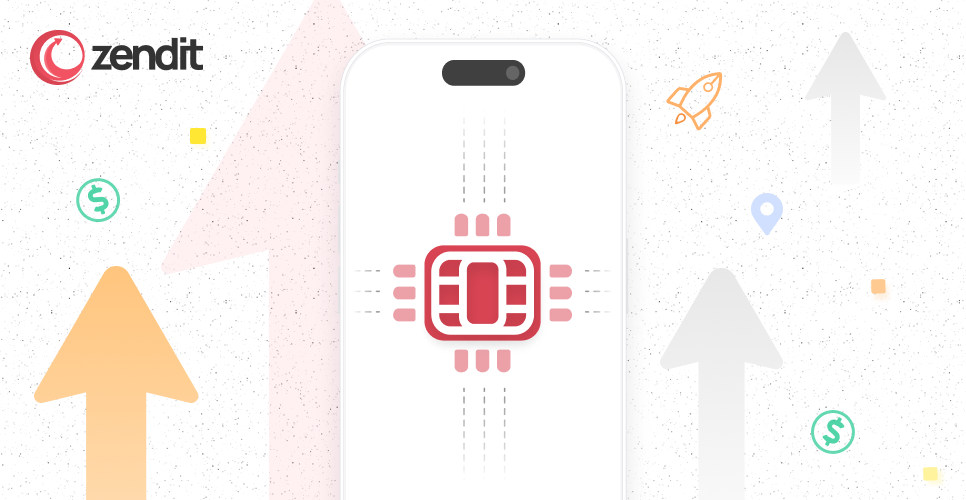
July 29, 2025
eSIM Reselling Made Easy: Set Up Your Digital Store and Sell Worldwide
The global eSIM market is rapidly expanding, creating new revenue opportunities for businesses that want to tap into the future of mobile connectivity. Here is the most cost-effective and seamless way to get started.
Global demand for eSIMs (also known as digital SIMs) is growing as more people become aware of their advantages over physical SIM cards.
The global eSIM market was valued at $10.32 billion in 2024, according to Grand View Research, a market research company. They also project that it will grow by 5.1% CAGR to become a $17.67 billion market by 2033.
As adoption of eSIM technology improves, demand for eSIM connectivity services like data plans will grow. Businesses that can meet this rising demand will open up new revenue streams and gain new customers from across the globe.
You can do this in the most stress-free and cost-effective way possible by signing up for an eSIM reseller platform. Once you integrate their API into your platform, you will gain access to global eSIM plans that you can easily resell for a profit.
In what follows, we consider how you can set up an eSIM reseller business and choose the eSIM reseller platform that will increase your chances of success. We’ll cover:
- How to become an eSIM reseller: What you need to get started
- What you should look for in an eSIM reseller platform
- How to integrate zendit’s eSIM reseller platform
Looking to profit from the growing eSIM market? Book a demo today to see how zendit’s eSIM reseller platform can help you build a profitable global eSIM reselling business.
1. How to become an eSIM reseller: What you need to get started
Given that travelers are some of the popular users of eSIM, providing access to global mobile operators is a necessity. A traveller going to Egypt from the United States, for example, will need access to local mobile operators in Egypt.
This would mean that to become an eSIM partner, a reseller needs to strike deals with hundreds of mobile operators across the globe, so they can list a wide range of data plans on their platform.
Of course, this would be a time-consuming and expensive process.
There is a better way: signing up with an eSIM reseller program.
If you take this alternative route, you only need three things to become an eSIM reseller:
An e-commerce platform
An e-commerce platform allows you to build and run an online store on your website or mobile app. Every time you purchase a product online from a store, there is an e-commerce platform powering everything.
It is where you would list products, set up payment methods and integration, and manage inventory.
If you are selling a product online, you already have an e-commerce platform.
However, if your business is service-oriented, eSIMs might be the first product you are selling online. To make the sales process smooth and seamless, you will need to integrate an e-commerce platform into your website and mobile app.
Some of the popular ones include Shopify, WooCommerce, BigCommerce, Wix, and Squarespace. Ensure you choose the one that can provide optimal customer experience, excellent experience, and the right mix of features.
An eSIM reseller platform
While the e-commerce platform handles the creation and maintenance of the eSIM store, the eSIM reseller platform (also known as a wholesale eSIM platform) provides the eSIM plans that you will be listing.
These platforms have an inventory of eSIM services from global mobile operators.
By integrating them, you can purchase wholesale eSIM data plans (at discounted prices) that you can list on your e-commerce platform. Unlike the direct approach, you don’t need to get licenses from hundreds of telecom operators.
Also, many of these platforms allow you to build whitelabel eSIM data plans; that is, the products you sell will carry your brand name and identities.
Marketing budget and strategy
The easiest way to get your eSIM business running is to cross-sell it to your current customer base.
Some of them might be frequent international travelers who are frustrated with the high cost of roaming and the inconvenience of purchasing local SIM cards to access local internet services. Or they might be people who want remote provisioning and the ease of switching carriers (in pursuit of the best service provider) without registering multiple SIM cards.
If you are an airline company, an online travel agency (OTA), or a travel operator, you can offer travel eSIM to your current customer base as an ancillary service.
While that is a good place to start from, you can extend your marketing efforts to corporate customers.
Businesses with an international presence can purchase eSIM mobile data plans for their employees all over the world as part of their rewards and incentives programs. They can do the same for employees travelling on the company’s behalf.
Even local businesses can embrace eSIM technology as a way for employees to separate work and personal lines without having to register different SIM cards or purchase multiple phones (given that most new smartphones only support a single SIM card).
In essence, you can become an eSIM supplier for businesses and not just individual users.
The more important point is that the market is large; with the right marketing budget and strategy (social media marketing, email marketing, among others), you can build a big business as a global eSIM reseller.
2. What you should look for in an eSIM reseller platform
Much of your success as a global eSIM reseller depends on the eSIM reseller platform you choose.
So, what should you be looking for in a wholesale eSIM platform?
There are at least 5 things:
Global access and variety
Businesses have remote workers across the globe, and people travel to different parts of the world.
To become an eSIM partner they can rely on, you need to offer global connectivity by providing access to mobile operators in many nations. This means choosing an eSIM reseller platform with a global scope.
Also, you want an eSIM reseller platform with an inventory that includes operators in nascent eSIM markets: Africa, South America, and the Middle East.
Since eSIMs are still largely unknown in these places, there is an opportunity to operate in a less competitive market (and even become a market leader).
Zendit is an example of an eSIM reseller platform that provides such global access. They have partnerships with more than 600 operators in 90 countries. With them, you can meet the needs of your corporate and individual customers.
Similarly, zendit lists eSIM data plans from operators in nascent markets like Africa, the Middle East and North Africa (MENA), Central America, Asia, and the Caribbean.
Customization and flexibility
A whitelabel eSIM allows you to include your brand name and identities on the products you are selling. This has the advantage of improving your brand awareness and making it easier to cross-sell other products and services to your eSIM customers.
Flexibility is all about the convenience of your customers. A good eSIM provider makes it easy for you to customize data packages that meet the data usage trends of your customers. This can mean including smaller (as small as 1GB, for example) or larger (as large as 1TB, for example) data plans, as well as unlimited ones.
Zendit provides both customization and flexibility.
Seamless connectivity
The eSIM services you offer for sale should be compatible with multiple smartphones (Samsung, Apple, Google Pixel, etc.) as well as other devices that use eSIM (tablets, laptops, smartwatches, cars, wearables, and IoT devices, etc.).
eSIM data plans offered by zendit can be used on any device.
Competitive deals
If you will be operating in competitive markets where margins are thin, then you should choose an eSIM provider with competitive deals. If your average cost price is higher than others, then you can’t compete in competitive markets.
Even if the market is not competitive, a competitive average cost will help you maximize your profit potential.
If you choose zendit’s eSIM solutions, you will enjoy competitive deals that will aid your profitability.
Easy, quick, scalable, and secure integration
Since you are using an external platform, you will need an application programming interface (API) to integrate it with your platform.
You want to choose an eSIM reseller platform that is easy and quick to integrate. The integration process should also be secure, protecting your data from unscrupulous elements. Finally, the API should be scalable – adjust to your needs. When you grow as an eSIM supplier for businesses and individuals, the API should seamlessly handle larger requests.
All these are what you get with zendit’s eSIM reseller API.
Furthermore, you can get any help you need during integration at zendit University or by contacting customer support.
3. How to integrate zendit’s eSIM reseller platform
As we have seen, zendit has everything you should look for in an eSIM reseller platform.
How, then, can you start reselling eSIM with zendit?
You can start by taking these few steps:
- Sign up for an account
The first step is to register an account with zendit. All you need at this stage is an email address, a password, and two-factor authentication.
- Access our eSIM catalog
When you log in to your account, you will land on the homepage.
The first section is the dashboard (sections are listed vertically on the left sidebar). Right below it is the product catalog (as seen below).
Select eSIM as the product type, and you will see a list of all the eSIM data plans that are on offer.
You can filter this list by region, country, subtype, data amount, and data duration.
This section gives you an overview of the global reach that zendit offers.
- Integrate our API to list our eSIM offers on your platform
The next step is to start listing these products on your platform. As said above, you will need to integrate our eSIM API to do this.
You can start the process in test mode before going live to production mode, so you can get more acquainted with the platform.
The test mode is the default mode when you have just created your account.
Irrespective of the mode, these are the steps to integrating our eSIM API:
- Get the authentication key: You can find the authentication key in the API settings section, as below:
As you can see here, the test mode (sandbox) is the default mode. If you are qualified to work in production mode, you can change to that mode before copying the API code.
Note that there is a link to the API documentation on the right-hand side of the API settings. This can come in handy at any stage of the process.
- Visit the Swagger page to make API requests: Zendit’s gateway API page on Swagger is where you can make API requests based on specific endpoints.
You will input the API key by clicking on the “Authorize” button at the bottom right.
- Get a list of eSIM offers: You will use the “GET eSIM offers” endpoint to show a list of available eSIM offers. This appears on Swagger like this:
The query parameters you need to fill in include:
The first two deal with how you want the list to appear, while the other ones allow you to filter the list based on a particular country, region, or brand.
You can also request a specific eSIM by inputting its productID:
- Purchase eSIM: You will use the “Post Purchases” endpoint to create an order for an eSIM data plan:
The query parameters are:
The “ICCID” (integrated circuit card identifier) is the identification number of the eSIM you are purchasing the data plan for. This is useful if you are purchasing a top-up data package for an existing eSIM. If the data purchase is for a new eSIM, you can omit this parameter.
“OfferID” is the identification number of the particular eSIM data plan in zendit’s catalog, while “transactionID” is the identification number you want to use to differentiate this product in your system.
- Retrieve the eSIM QR code: Given the reality of eSIM security risks, end users will need a QR code for eSIM activation.
You can retrieve the QR code associated with every purchase by using the “GET QR Code” endpoint:
The only query parameter is the transaction ID:
- Get a list of transactions: The “GET Transactions” endpoint pulls up all the transactions you have generated:
The query parameters are as below:
You can filter for transactions by date (the “createdAt” string) and status.
Also, if you are interested in the details of a particular transaction, you can search for it using its transaction ID:
- Receive real-time transaction details with webhooks: Adding a webhook is a good way to get real-time updates on transactions.
Webhooks are available at the bottom left of the API settings section, as seen below:
When you click on “Add new webhook,” you will get to this page:
Choose “eSIM webhook” and complete the process.
4. Go live by funding your wallet and supplying business details
If you have done the integration in test mode, you will need to move to production mode to start reselling actual eSIM data plans.
Also, you can start with this step (going live in production mode) and then go back to step 3 to integrate in production mode.
When you click on “go live” from any part of the homepage, you will land here:
You will need to fill in some details about your business and set up a payment method to go to production mode.
5. Access reports of your activities
Once you have gone live and have started making purchases, zendit will provide transaction reports that will help you understand your activities.
There are three reports: summary, transactions, and account statement.
The summary report is like an income statement showing total revenue, profit, and profit margins for a given period.
If you switch to the transactions report, you will get a list of all transactions you have created within a given period. The details you will find include the date of the transaction, mobile operator, offer ID, transaction cost, and transaction status.
Finally, the account statement is like a statement of account you get from the bank. It shows all the debits and credits on your wallet within a given period.
As the eSIM market continues to grow, smart businesses that choose the right eSIM reseller platform can expand their customer base and revenue streams.
With zendit, you will get access to global mobile operators, competitive deals, whitelabel eSIM data plans, flexible data plans, and data plans that are compatible with multiple devices.
Moreover, you can integrate zendit’s user-friendly API in an easy, quick, scalable, and secure way.
Are you ready to become a profitable global eSIM reseller? Register for zendit now or book a demo to better understand how our eSIM reseller platform can benefit your business.
Takeaways
- Valued at $10.32 billion in 2024 and projected to hit $17.67 billion by 2033, the eSIM market presents a lucrative opportunity for businesses to resell data plans, especially as more travelers and enterprises adopt the technology.
- Instead of negotiating with hundreds of telecom operators, you can join a wholesale eSIM platform like zendit to access and resell global data plans with your own brand name and identities, all by integrating a simple API.
- The best platforms offer global coverage (including nascent markets), customizable whitelabel plans, hassle-free device compatibility, competitive pricing, and secure, scalable API integration. Zendit provides all of these and more.
- You can start by cross-selling to existing customers (especially travelers or remote workers), then expand into B2B by offering businesses eSIMs for international staff, employee perks, or telecom flexibility.

